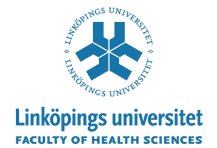 |
Visa svensk kursplan |
|
COURSE CATEGORY Single subject course MAIN FIELD OF STUDY Medical Biology SUBJECT AREA Medical Biology |
COURSE CODE | 8FA226 |
LEARNING OUTCOMES
After the course the student will be able to:
Knowledge and understanding
- Account for what kind of biological, physiological and pathophysiological processes that can be studied with molecular imaging
- Describe the contrast mechanisms in different molecular imaging modalities
- Describe methods for quantification in molecular imaging and how they relate to studied biological or physiological process
- Describe different visualization techniques in molecular imaging
- Account for how different molecular imaging techniques and other imaging techniques are combined to improve the interpretation of molecular imaging
Competence and skills
- Use image analysis and visualization software to interpret and visualize the result from a molecular imaging experiment
Judgement and approach
- Evaluate advantages and disadvantages of different molecular imaging techniques when applied in different clinical and pre-clinical situations
- Image generation technology: Positron Emission Tomography (PET), Single Photon Emission Computed Tomography (SPECT), Magnet Resonance (MR), MR-spectroscopy, hyperpolarized MR, Electron Paramagnetic Resonance Imaging (EPR), Computed Tomography (CT), Ultrasound Imaging (US), optical methods, and electron microscopy.
- Contrasts mechanisms in molecular imaging
- Use of micro-dosing in drug design
- Image quantification, image analysis, and image visualization techniques
Specific: In this course, lectures, laboratory exercises and seminars are used.
Active participation in the compulsory parts is necessary to pass the course, and assessment of them is carried out continuously. Compulsory parts in this course are: laboratory exercises and seminars.
EXAMINATION
Individual written examination.
Oral presentation of laboratory exercises results (group assignment with individual assessment).
SCOPE OF RE-EXAMINATION
The extent of a re−examination shall be similar to the regular examination.
CHANGE OF EXAMINERS
Students who have failed the course or part of the course twice are entitled to request another examiner for the following examination occasion, unless specific reasons are present.
REGISTRATION FOR EXAMINATION
The procedure for registration should be stated prior to the commencement of each course. In other respects, regulations concerning examination and examiners are applied in accordance with Linköping University policy.
Applicants must also have documented knowledge of English equivalent to Engelska B/Engelska 6; i.e. an internationally recognized test, e.g. TOEFL (minimum scores: Paper based 575 + TWE-score 4.5, and internet-based: Score of 20 (scale 0-30) in written test, total score of 90), IELTS, academic (minimum score: Overall mark of 6.5 and no section below 5.5), or equivalent.
The course is carried out in such a way that both men’s and women’s experience and knowledge is made visible and developed.
If the course is withdrawn, or is subject to major changes, examinations according to this course plan are normally offered on a total of three occasions within one year, one of them in close connection to the first examination.
|
||||||||||||||||||||||||||||||||||||||||||||||||||||||||||||||||||||||||||||||